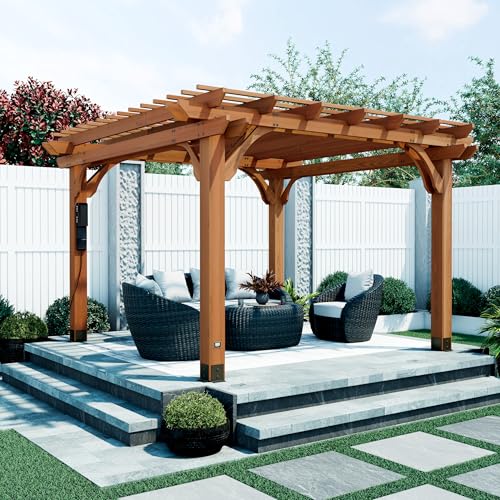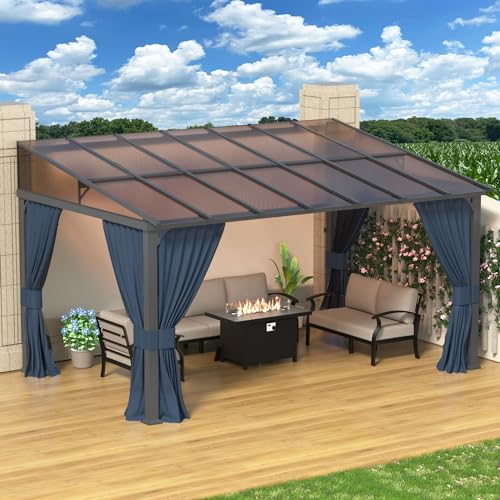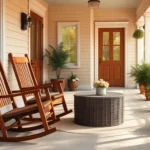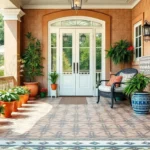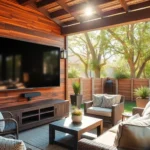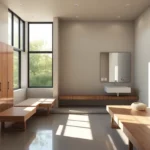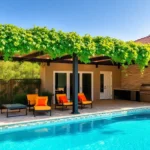Transforming your outdoor space into a stunning retreat doesn’t require a complete backyard overhaul. An attached pergola can instantly elevate your patio’s style while creating the perfect blend of indoor comfort and outdoor freedom. We’ve discovered that homeowners are increasingly drawn to these versatile structures because they offer both practical shade and architectural beauty.
Attached pergolas serve as natural extensions of your home, creating seamless transitions between interior and exterior living spaces. Whether you’re dreaming of a cozy morning coffee nook or an elegant entertaining area, these structures provide the foundation for countless design possibilities.
We’ll explore creative ideas that work with any home style, from modern minimalist designs to rustic farmhouse aesthetics. You’ll discover how the right pergola can increase your property value while giving you that coveted outdoor room you’ve always wanted.
Traditional Wooden Pergola Designs for Classic Home Styles
Traditional wooden pergolas bring timeless elegance to homes with classic architectural styles. We’ve found these designs complement colonial, craftsman, and farmhouse aesthetics perfectly while maintaining the sophisticated appeal homeowners desire.
Cedar and Pine Construction Options
Cedar stands as our top recommendation for traditional pergola construction due to its natural resistance to insects and weather damage. This premium wood choice offers rich grain patterns and naturally weathers to an attractive silver gray patina over 10-15 years. Cedar pergolas typically cost 20-30% more than pine but require minimal maintenance throughout their lifespan.
Pine construction provides an excellent budget-friendly alternative for homeowners seeking classic wooden pergola aesthetics. We recommend pressure-treated pine lumber for outdoor applications since it resists rot and pest damage effectively. Pine pergolas accept stains and paints beautifully, allowing you to customize colors to match your home’s exterior palette.
Douglas fir represents another excellent traditional option that balances cost with durability. This wood species features straight grain patterns and natural strength that supports larger pergola spans without additional bracing. Douglas fir pergolas work exceptionally well for colonial and craftsman style homes where structural integrity meets visual appeal.
Lattice Top Patterns for Partial Shade
Classic grid lattice patterns create approximately 40-50% shade coverage while maintaining an open, airy feeling beneath the pergola. We typically space lattice boards 4-6 inches apart to achieve optimal light filtering without blocking too much natural illumination. These patterns work beautifully for morning coffee areas where gentle shade enhances comfort.
Diagonal lattice designs add visual interest while providing similar shade benefits to traditional grid patterns. This arrangement creates diamond shaped openings that cast attractive shadow patterns throughout the day. Diagonal lattice works particularly well with craftsman and colonial home styles where geometric details enhance architectural character.
Herringbone lattice patterns offer sophisticated visual appeal for upscale traditional homes seeking distinctive pergola tops. We arrange boards in alternating V-shaped sections that create complex shadow play while filtering approximately 60% of direct sunlight. These intricate patterns require skilled craftsmanship but deliver stunning results for entertaining areas.
Staining and Finishing Techniques
Natural wood stains enhance grain patterns while protecting pergola lumber from UV damage and moisture penetration. We recommend semi-transparent stains in warm brown or honey tones that complement traditional home exteriors beautifully. These finishes typically require reapplication every 3-4 years depending on climate conditions and sun exposure.
Solid color stains provide complete coverage while maintaining wood texture beneath the finish. White, cream, and sage green solid stains create striking contrasts against brick or stone home exteriors. Solid stains last 5-7 years before requiring touch-ups, making them practical choices for low-maintenance pergola care.
Clear protective sealers preserve natural wood appearance while adding water resistance and UV protection. We apply these products annually to maintain optimal wood condition and prevent premature aging. Clear sealers work best on premium woods like cedar that showcase beautiful natural coloring and grain characteristics.
Modern Metal Pergola Structures for Contemporary Homes
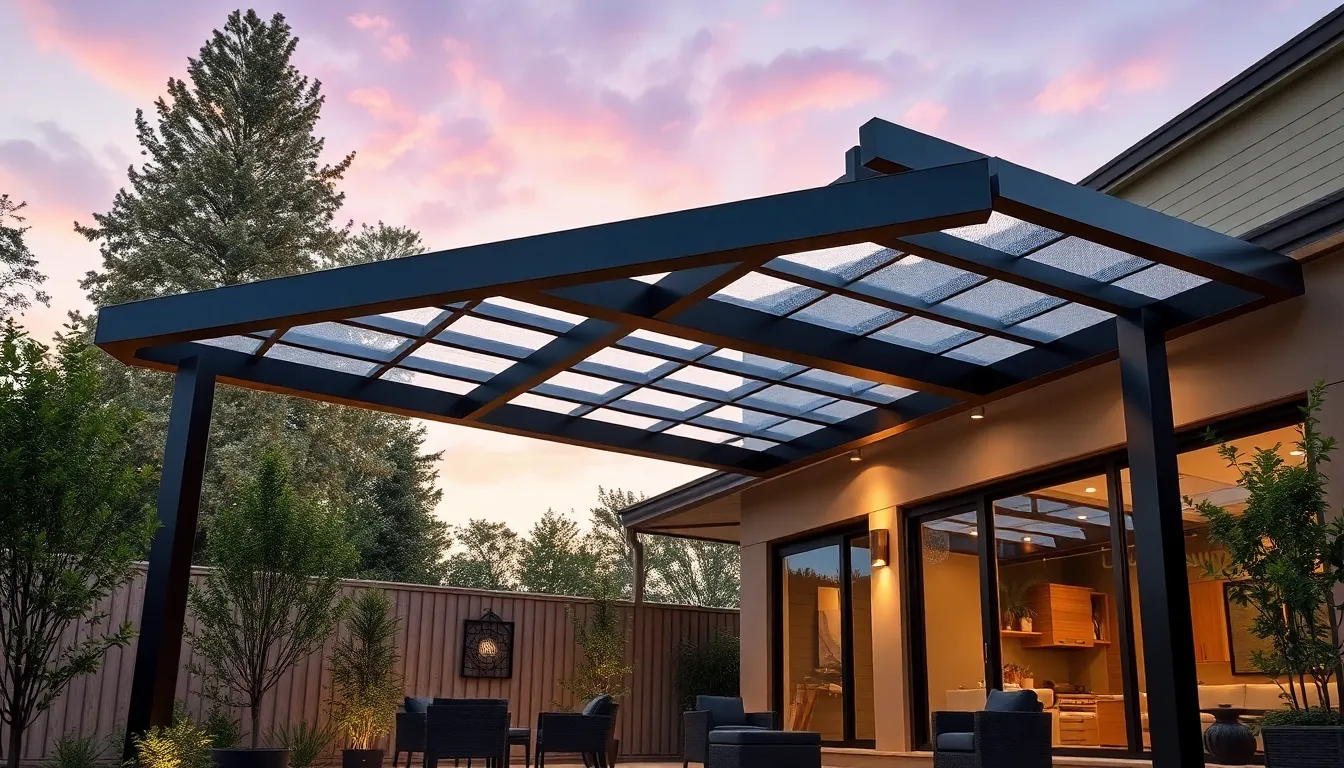
Modern metal pergolas offer sleek alternatives to traditional wooden structures, bringing industrial elegance to contemporary home designs. We’ve seen these structures seamlessly extend living spaces from indoors to outdoors while maintaining the clean lines that define modern architecture.
Aluminum Frame Benefits and Durability
Aluminum pergolas deliver exceptional value through their lightweight construction and remarkable weather resistance. These structures resist corrosion naturally, eliminating the rust concerns that plague other metals in outdoor environments. Maintenance becomes virtually effortless since aluminum frames don’t require regular staining, sealing, or replacement like wooden alternatives.
Heavy duty aluminum frames provide impressive longevity that often comes with lifetime warranties from manufacturers. Weather conditions ranging from intense UV exposure to heavy snow loads rarely compromise aluminum’s structural integrity. Customization options remain virtually unlimited since aluminum’s malleability allows for complex geometric shapes and intricate design details.
Warping and rotting become non issues with aluminum construction, making these pergolas ideal for regions with extreme temperature fluctuations. Installation typically requires less structural support compared to heavier materials, reducing both complexity and cost.
Steel Pergola Design Elements
Steel pergola construction brings industrial strength to outdoor living spaces while creating bold architectural statements. Geometric shapes become possible with steel’s superior load bearing capacity, allowing for dramatic cantilevers and expansive spans without intermediate support posts. Modern steel pergolas incorporate clean angles and minimalist profiles that complement contemporary home facades.
Wooden accent integration works beautifully with steel frames, creating warm contrasts against the metal’s cool industrial aesthetic. Lighting systems embed seamlessly into steel structures, enabling integrated LED strips or pendant fixtures that enhance evening ambiance. Open air designs balance shade coverage with natural light filtering, creating comfortable outdoor rooms that aren’t completely enclosed.
Industrial aesthetics emerge through exposed beam connections and purposeful hardware displays that celebrate the material’s engineering properties. Steel’s strength allows for thinner profile members compared to aluminum, creating more refined visual proportions.
Powder-Coated Color Options
Powder coating technology transforms metal pergolas into custom design elements that perfectly match exterior color schemes. This finishing method applies electrostatically charged powder particles that cure into durable, uniform coatings under high heat. Protection against fading, scratching, and chipping far exceeds traditional paint finishes, maintaining color vibrancy for decades.
Color palette options range from classic blacks and grays to vibrant blues, greens, and custom hues that complement exact architectural styles. Texture variations include smooth finishes, subtle textures, and even wood grain patterns that combine metal durability with natural aesthetics. Multiple coating layers create depth and richness that single coat applications can’t achieve.
Weather resistance improves significantly with powder coating since the finish bonds chemically rather than just adhering to the surface. Maintenance involves simple soap and water cleaning, with no need for periodic repainting or touch up work that other finishes require.
Retractable Canopy Pergolas for Flexible Coverage
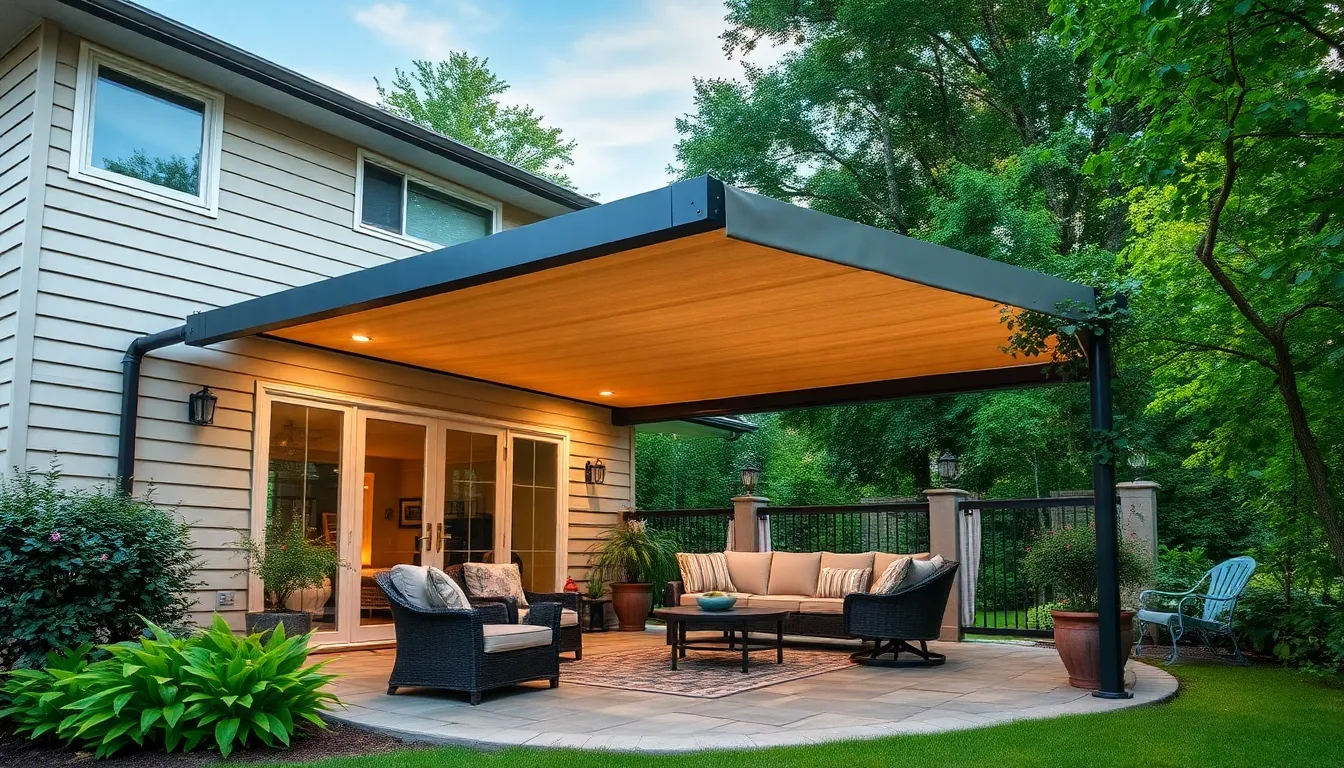
Retractable canopy pergolas bridge the gap between open sky enjoyment and weather protection needs. These innovative systems let you adjust shade coverage throughout the day while maintaining your pergola’s architectural appeal.
Motorized Retractable Systems
Motorized retractable systems transform your pergola experience with the simple push of a button. These electric mechanisms extend or retract your canopy smoothly and precisely, eliminating the physical effort required for manual operation. We’ve found that homeowners particularly appreciate the convenience during sudden weather changes or when hosting outdoor gatherings.
Electric motors in these systems are typically weatherproof and designed for frequent use. Installation requires electrical connections, but the investment pays off in daily usability and long term convenience. Most motorized systems include remote controls or smartphone app integration for even greater ease of operation.
Manual Pull-Cord Mechanisms
Manual pull cord mechanisms offer a cost effective alternative to motorized systems without sacrificing functionality. These simple designs use a cord and pulley system that allows you to extend or retract the canopy with moderate physical effort. We recommend this option for homeowners who want retractable coverage but prefer lower maintenance answers.
Rope and pulley systems in manual mechanisms are straightforward to repair and replace when needed. Most homeowners find the operation becomes second nature after a few uses. Installation costs remain significantly lower than motorized alternatives while still providing the flexible coverage you desire.
Weather-Resistant Fabric Choices
Weather resistant fabrics form the foundation of any successful retractable canopy system. These specialized materials endure sun exposure, rain, and wind while maintaining their color and structural integrity over multiple seasons. We’ve observed that high quality fabrics can last 5-7 years with proper care and maintenance.
Acrylic fabrics lead the market for their exceptional UV resistance and water repellent properties. Polyester blends offer another durable option with excellent color retention and mildew resistance. Canvas materials provide a traditional aesthetic while delivering reliable weather protection for your outdoor living space.
Fabric weight ratings typically range from 8-12 ounces per square yard, with heavier weights providing enhanced durability and wind resistance. Color choices span from neutral tones that complement any home style to bold patterns that create striking focal points in your outdoor design.
Pergola Integration with Existing Roof Lines
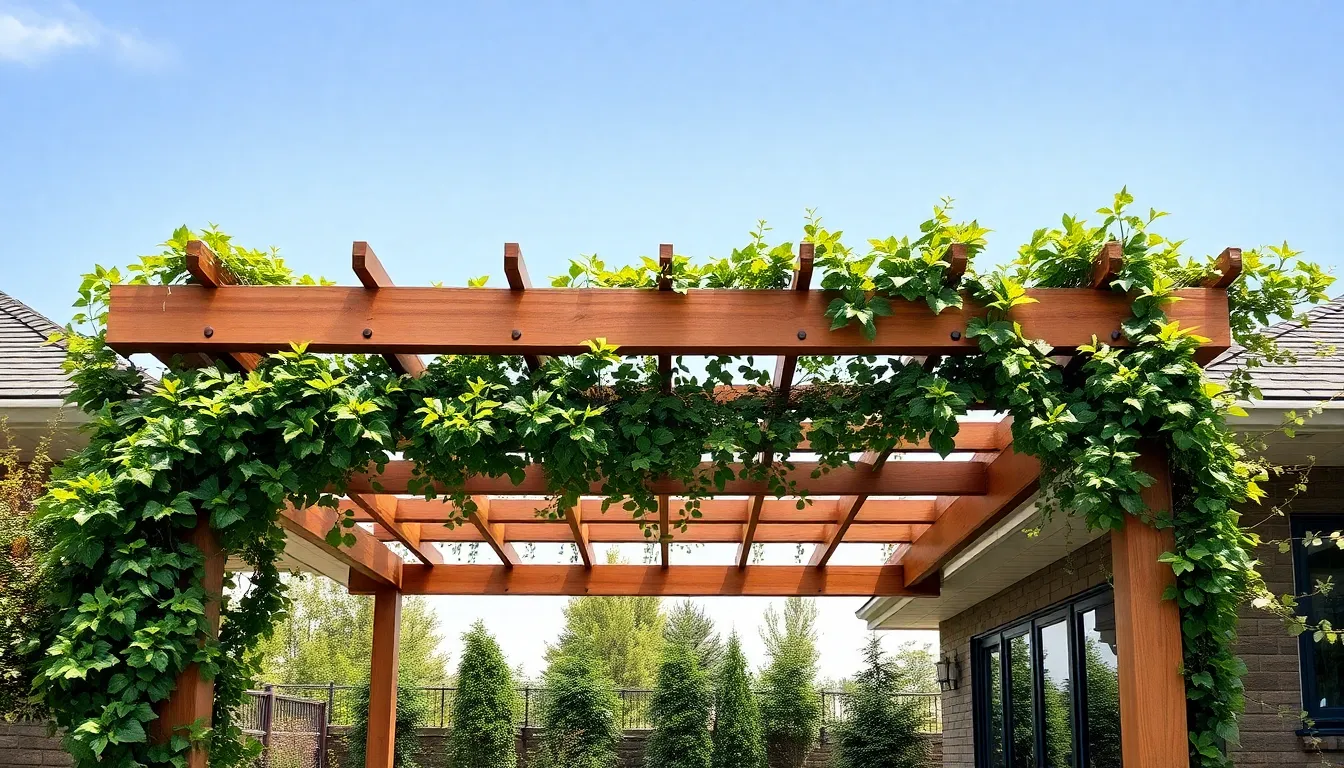
Successful pergola integration requires careful alignment with your home’s existing roof structure to create a cohesive outdoor extension. We’ll explore how to achieve seamless architectural harmony through proper design choices and installation techniques.
Matching Architectural Elements
Wood and glass panel pergolas create stunning visual connections by echoing your home’s window panes or siding patterns. We recommend choosing materials that complement your existing exterior finishes rather than competing with them.
Roof pitch alignment ensures your pergola feels like a natural extension of your house architecture. Matching the slope angle helps water drainage flow properly while maintaining visual continuity across the roofline.
Color coordination between your pergola and home’s trim details prevents the structure from looking like an afterthought. We suggest sampling paint colors or stain options directly against your house’s exterior before making final selections.
Planting vines or hanging plants softens the transition between your pergola structure and surrounding industry. Climbing roses, wisteria, or grape vines create natural screening while adding seasonal interest to your outdoor space.
Proper Attachment Methods to House Structure
Ledger board installation serves as the primary connection point between your pergola and house framing. We secure this horizontal support beam directly to your home’s wall studs using heavy duty lag bolts or structural screws.
Proper flashing and waterproofing prevent water intrusion at the ledger board connection point. Metal flashing diverts rainwater away from the attachment area while weatherproof sealants protect against moisture damage.
Heavy duty aluminum frames with vinyl exteriors increase structural durability while reducing long term maintenance requirements. These materials resist rust, warping, and insect damage better than traditional wood construction.
Post support systems on the patio side balance the structural load with your house attachment. We typically space support posts 8 to 12 feet apart depending on your pergola’s span and local wind load requirements.
Professional Installation Considerations
Structural assessment by qualified contractors ensures your house can safely support an attached pergola’s weight and wind loads. We evaluate existing wall framing, foundation conditions, and roof connections before beginning installation.
Building code compliance varies by location and requires professional expertise to navigate properly. Licensed installers understand local setback requirements, height restrictions, and permit processes that affect your pergola project.
Custom modifications accommodate unique roof lines, unusual wall materials, or exact architectural features of your home. Professional installers can suggest design adjustments that work with your property’s existing conditions.
Warranty protection comes standard with professional installation services, covering both materials and workmanship for several years. We guarantee structural integrity and weather resistance when proper installation methods are followed.
Climbing Plant Integration for Natural Beauty
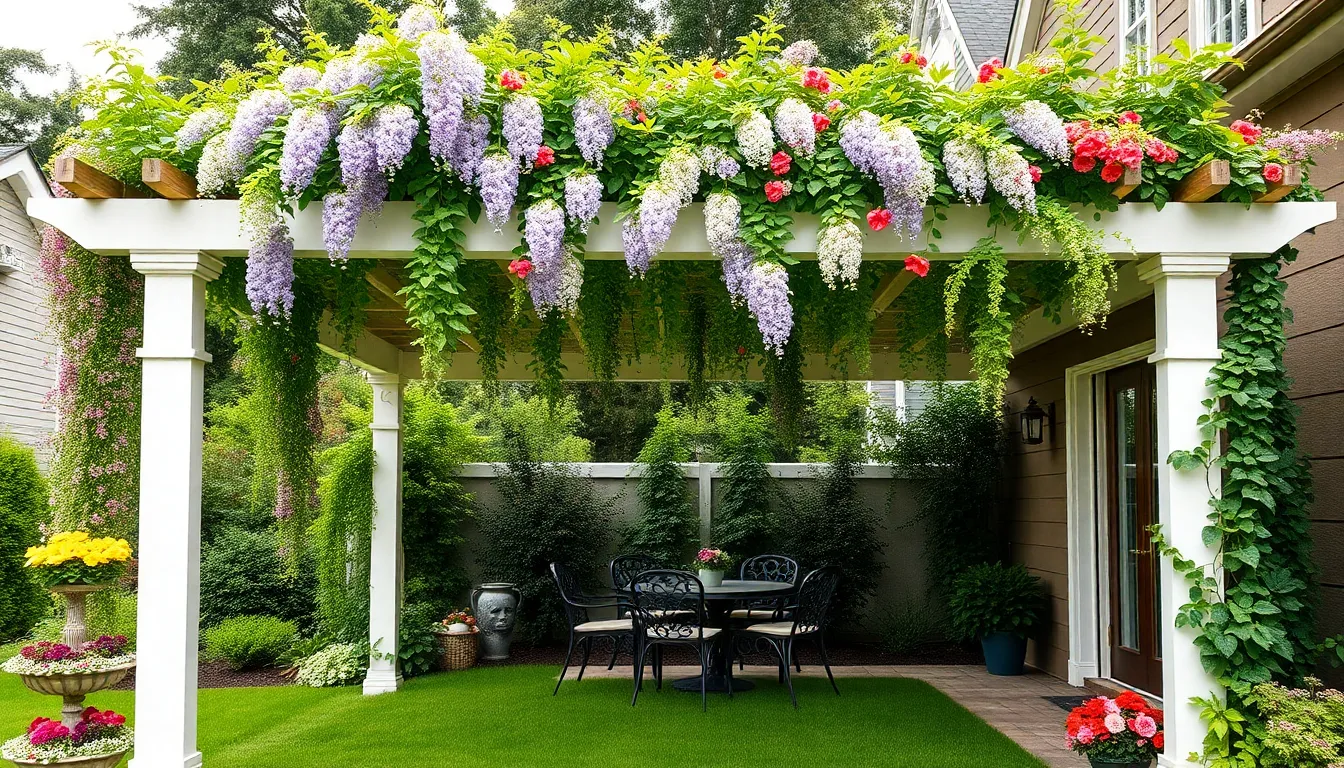
Transforming your attached pergola into a living, breathing extension of your home starts with strategic climbing plant integration. We’ve found that vines create the perfect marriage between architectural structure and natural beauty, providing both functional shade and stunning visual appeal.
Best Vine Varieties for Pergola Coverage
Wisteria stands out as our top recommendation for dramatic seasonal impact, producing cascading clusters of purple or white flowers that create a breathtaking canopy effect. This vigorous climber provides excellent coverage across pergola rafters while delivering that wow factor every spring.
Clematis offers incredible versatility with its variety of colorful flowers, blooming profusely in many different climate zones throughout the growing season. We love how this vine adapts to different pergola styles while providing consistent, beautiful coverage.
Trumpet Vine brings vibrant orange-red flowers that naturally attract hummingbirds, creating a bright, lively display perfect for entertaining spaces. This hardy climber covers pergola structures quickly and thrives in various growing conditions.
Bougainvillea thrives in warmer climates, producing brilliant pink, purple, or red bracts that add tropical flair to any attached pergola design. We recommend this vine for homeowners seeking year-round color in Mediterranean or desert climates.
Jasmine provides both fragrant white or yellow flowers and dense coverage, making it ideal for pergolas near seating areas where you’ll appreciate the sweet scent. This reliable climber works well for creating intimate, enclosed outdoor rooms.
Planting and Maintenance Tips
Prepare your planting site by ensuring well-draining soil enriched with organic matter, which supports vigorous vine growth essential for full pergola coverage. We recommend testing soil pH and amending as needed before planting.
Plant your selected vines at least one foot away from pergola posts, allowing adequate space for root expansion and preventing potential structural issues. This distance also makes future maintenance much easier.
Train new vine growth by gently tying shoots to pergola beams until they develop natural clinging mechanisms or wrapping abilities. We use soft plant ties to avoid damaging tender new growth.
Prune regularly to control growth patterns, maintain desired shapes, and encourage prolific flowering throughout the growing season. Most climbing vines benefit from annual pruning during their dormant period.
Water consistently during the establishment period, maintaining steady moisture levels without creating waterlogged conditions that can damage root systems. We recommend deep, less frequent watering once vines are established.
Monitor for common pests like aphids or spider mites, treating early infestations before they spread throughout your pergola coverage. Regular inspection prevents major pest problems from developing.
Seasonal Color Considerations
Spring delivers early seasonal interest through wisteria and clematis blooms, providing the first burst of color after winter dormancy. These early flowering vines signal the beginning of your pergola’s growing season.
Summer brings peak performance from trumpet vine and jasmine, offering vibrant flowers and delightful fragrance during prime outdoor entertaining months. We love how summer bloomers create the perfect backdrop for patio gatherings.
Fall transforms some climbing vines through changing leaf colors or berry production, adding visual interest as other garden elements begin their dormant phase. This seasonal transition keeps your pergola attractive year round.
Winter structure becomes more visible, allowing you to appreciate your pergola’s architectural elements while planning for next year’s vine growth and training. Deciduous vines reveal the pergola framework during colder months.
Selecting multiple vine varieties with staggered bloom times ensures continuous seasonal color around your attached pergola throughout the entire growing season.
Lighting Solutions for Evening Ambiance
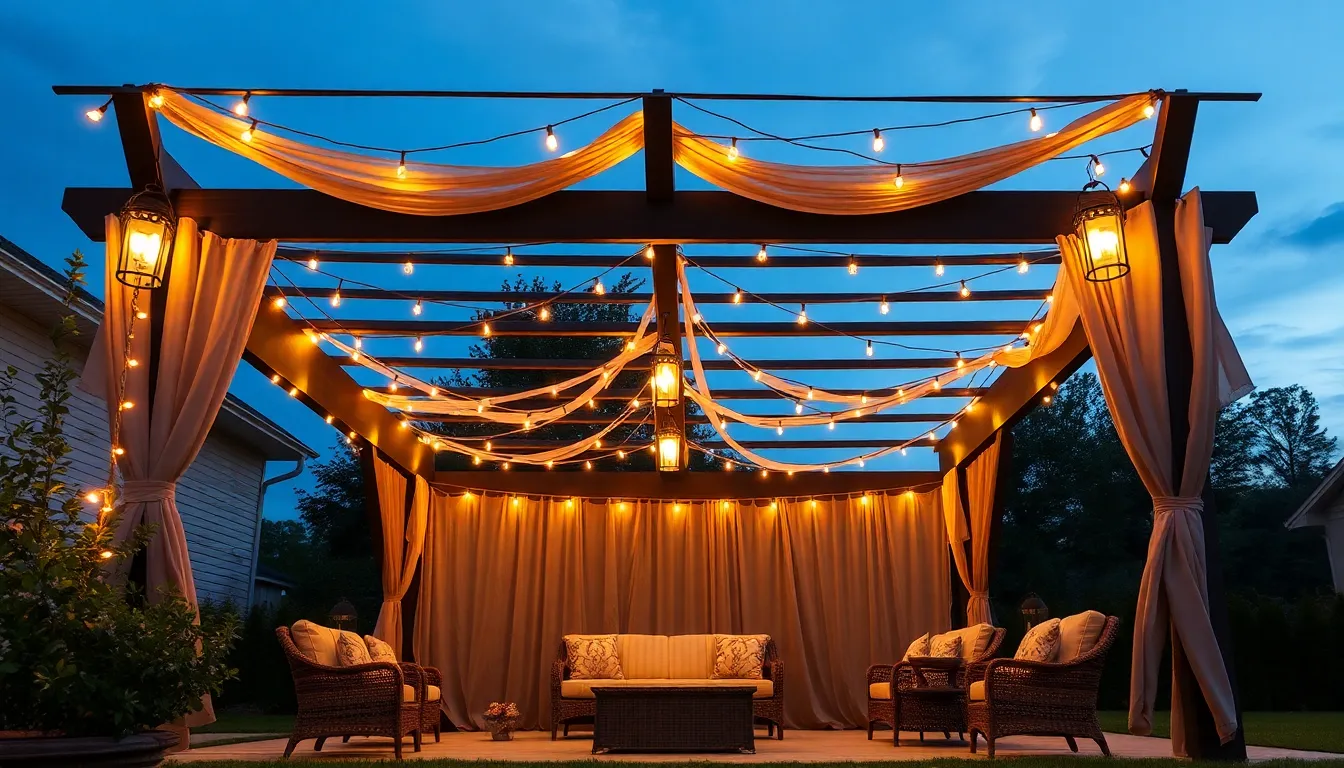
Transform your attached pergola into a magical evening retreat with the right lighting choices. Strategic illumination extends the usability of your outdoor space well into the night while creating an inviting atmosphere for entertaining or relaxation.
String Light Installation Ideas
String lights offer the most popular and charming way to add warmth to your attached pergola space. Draping these lights across the pergola ceiling creates a canopy effect that mimics a starlit sky above your outdoor seating area. Hanging them in scalloped designs from the center point to each column adds visual interest and frames the space beautifully.
Extending string lights outward to nearby trees or pathways helps connect your pergola to the broader industry design. We recommend combining string lights with fabric swags to create elegant draping that softens the hard lines of your pergola structure. Adding decorative elements like Moravian stars or lanterns creates focal points that enhance the overall ambiance.
Built-In LED Options
Built-in LED strip lights provide subtle and energy-efficient illumination along pergola beams and edges. Installing these lights creates a seamless modern aesthetic that doesn’t compete with your home’s architectural features. LED technology offers impressive versatility with color options and dimmable features that let you customize lighting schemes throughout the evening.
Recessed LED fixtures deliver clean lines that integrate directly into your pergola structure without visible hardware. We particularly appreciate how integrated lighting systems enhance ambiance without overpowering the natural surroundings. These installations work especially well with contemporary home designs where clean aesthetics matter most.
Solar-Powered Lighting Systems
Solar-powered lighting eliminates the need for complex wiring while providing eco-friendly illumination for your attached pergola. These systems harness sunlight during daylight hours and automatically illuminate your space after sunset. Solar LED string lights or spotlights positioned around pergola columns cast gentle glows that highlight structural elements.
Installation becomes remarkably simple with solar systems since they require no electrical connections to your home. We find these particularly valuable for attached pergolas where running electrical lines might be challenging or expensive. Solar lighting reduces ongoing energy consumption while providing reliable illumination throughout the evening hours.
Size and Scale Planning for Your Patio Space
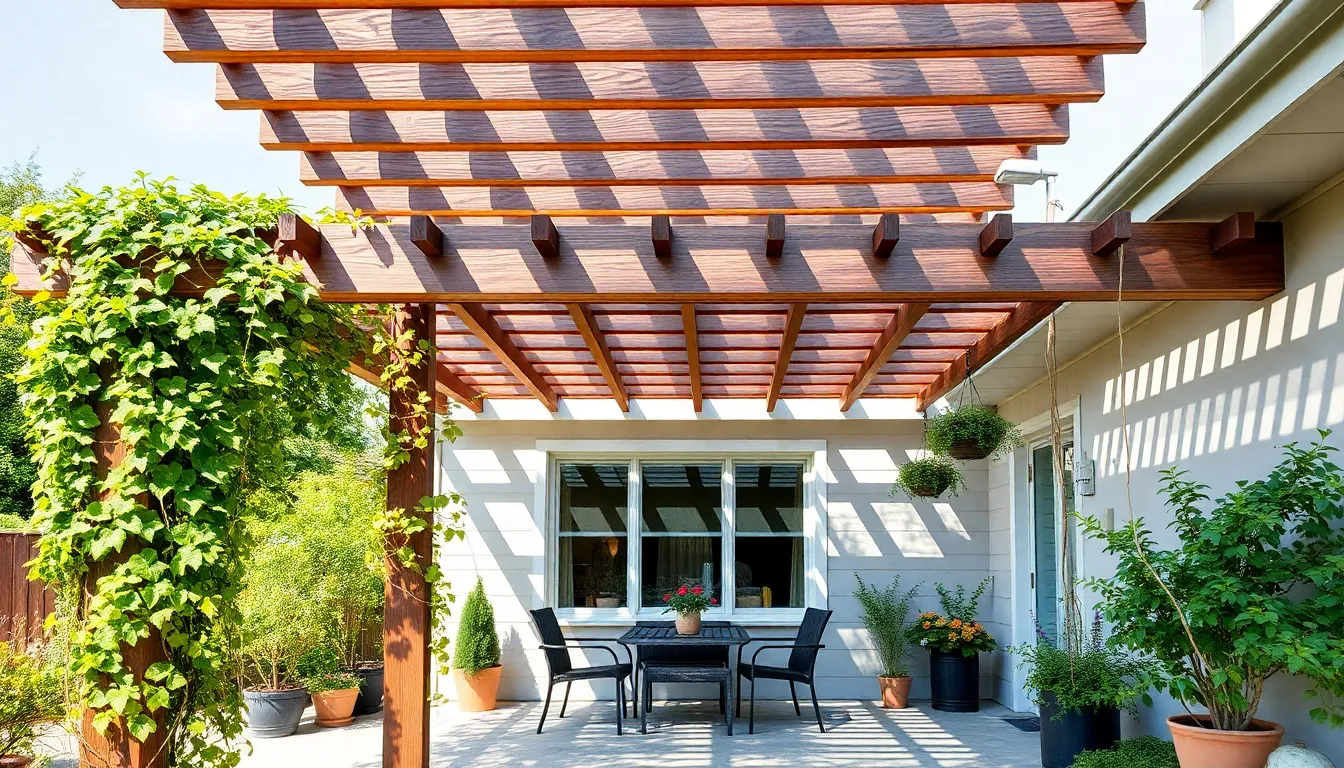
Getting the dimensions right for your attached pergola creates the foundation for a beautiful and functional outdoor space. We’ll help you navigate the essential measurements and design principles that ensure your pergola complements your home perfectly.
Measuring Techniques for Proper Fit
Start by measuring the width of your house wall where you plan to attach the pergola to determine the optimal pergola width. This measurement establishes the maximum span available and helps you visualize how the structure will look against your home’s facade.
Calculate the desired projection outward from your house to define the pergola’s depth and establish your usable shaded area. Most homeowners find that 10 to 16 feet provides adequate coverage for dining sets or lounge furniture without extending too far into the yard.
Document the locations of doors, windows, and existing outdoor furniture to ensure proper clearance and functionality. We recommend maintaining at least 3 feet of clearance around doors and windows to prevent the pergola from blocking natural light or hindering access.
Measure the height from your patio surface to potential attachment points on your house wall to determine appropriate pergola height. Standard attached pergolas range from 8 to 10 feet in height, providing adequate headroom while maintaining proportional balance with most home styles.
Proportional Design Guidelines
Choose pergola dimensions that complement your house facade without overwhelming the architecture. Common pergola sizes range from 8×8 to 20×20 feet, with custom dimensions available to achieve the perfect fit for your exact space and home style.
Align your ledger board attachment with existing siding and trim lines for a cohesive appearance that looks intentionally designed rather than added as an afterthought. This alignment creates visual continuity between your home’s architecture and the new pergola structure.
Select structural elements using standard lumber sizes like 2×8 beams and 6×6 posts to maintain both strength and proportional aesthetics. These dimensions provide the necessary support while creating pleasing visual proportions that don’t appear oversized or undersized.
Space your rafters and slats evenly to create a balanced rhythm of light and shadow beneath the pergola. We typically recommend 16 to 24 inch spacing between rafters, which provides adequate shade while allowing air circulation and partial sunlight to filter through.
Space Optimization Strategies
Position your pergola as an extension of your indoor living space by attaching it near kitchen sliders or patio doors to help natural flow and convenience. This placement maximizes the connection between indoor and outdoor areas, making the pergola feel like an integral part of your home.
Use vertical space by incorporating hanging plants or training climbing vines on the pergola frame to add greenery without sacrificing valuable ground area. Vines like clematis or jasmine can transform the structure into a living canopy while maintaining the open, airy feel.
Design your pergola with an open air configuration that provides shade while allowing airflow, creating a comfortable environment for activities like barbecuing or entertaining guests. This approach prevents the space from feeling enclosed while still offering protection from direct sunlight.
Scale your outdoor furniture to match the pergola footprint to create functional zones without overcrowding the space. A well proportioned dining set or lounge area should occupy about 60 to 70 percent of the pergola’s footprint, leaving room for movement and additional activities.
Budget-Friendly DIY Pergola Construction
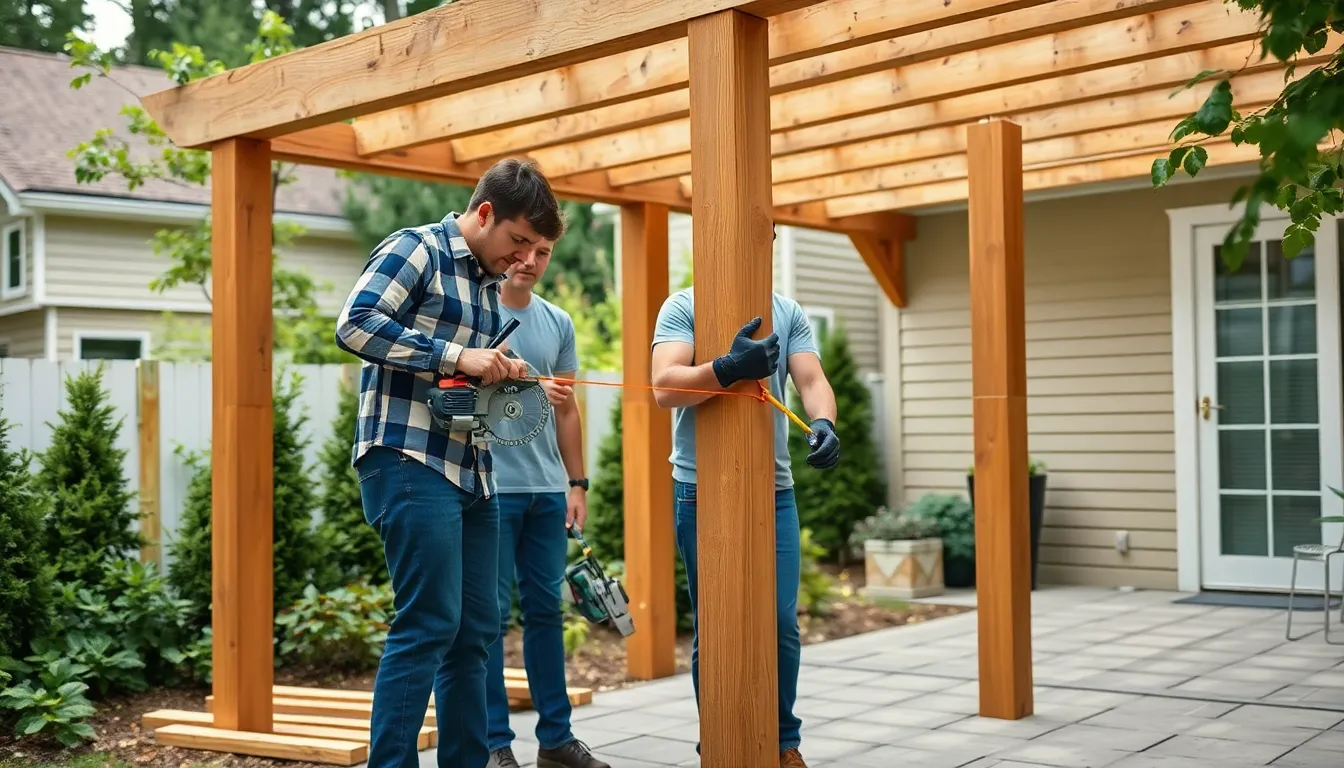
Building your own attached pergola doesn’t require a massive investment or professional contractor. With proper planning and the right approach, we can create a stunning outdoor structure that enhances our patio space while staying within budget.
Essential Tools and Materials List
Lumber and Hardware Requirements
Pressure treated lumber forms the backbone of our pergola project, typically requiring 6×6 posts for structural support and 2×6 or 2×8 beams and rafters for the overhead framework. Post bases with metal anchors secure our structure directly to the existing patio or concrete surface, eliminating the need for expensive concrete footings.
Cutting and Fastening Tools
We’ll need a circular saw or miter saw for precise lumber cuts, plus a drill with various bits for creating pilot holes and driving screws. HeadLOK screws provide exceptional holding power for connecting major structural components, while a concrete drill with masonry bit handles any patio anchoring requirements.
Measuring and Safety Equipment
A level and measuring tape ensure our pergola stands perfectly straight and proportioned to our patio space. Safety gear including gloves and eye protection keeps us protected during construction, while temporary bracing materials like spare 2x4s support posts during the installation process.
Step-by-Step Building Process
Planning and Layout Phase
We start by measuring our patio dimensions and designing a pergola that typically spans around 8×8 feet with appropriate overhang. Post placement requires careful consideration of patio slope and the house attachment point to ensure structural integrity and proper water drainage.
Foundation and Post Installation
Mark post locations precisely on the patio surface, then install post bases anchored directly into the concrete. Adjust measurements to accommodate any patio slope, ensuring posts remain plumb and level throughout the structure.
Lumber Preparation and Assembly
Cut posts to the required length and prepare any necessary tenons or notches for beam connections. Chamfer post edges for enhanced aesthetics, then pre drill holes in posts and beams to prevent wood splitting during fastening.
Structural Erection
Place posts into their bases and brace temporarily with stakes and 2x4s to maintain proper alignment. Secure posts firmly through the base connections, then attach the structure to the house using properly flashed ledger boards to prevent water damage.
Beam and Rafter Installation
Install beams across the post tops, followed by evenly spaced rafters that create both structural integrity and the desired shade pattern. Sand rough edges and apply protective stain or paint for weather resistance.
Cost-Saving Tips and Alternatives
Material Selection Strategies
Choose pressure treated wood or cedar for the optimal balance of durability and cost effectiveness. Purchase standard sized lumber to avoid custom cuts, which reduces both waste and expense while simplifying the building process.
Foundation and Labor Alternatives
Heavy duty post bases that anchor directly to existing patios eliminate the need for expensive concrete footings. Consider reclaimed wood or locally sourced materials to significantly reduce material costs without compromising quality.
Design and Construction Efficiencies
Skip elaborate decorative cuts or complex designs in favor of clean, simple lines that build faster and require fewer specialized tools. Complete the labor ourselves or organize a weekend building party with friends instead of hiring professional contractors, potentially saving hundreds of dollars on installation costs.
This DIY approach typically requires about two days of focused work and uses common materials available at most home improvement stores, making it an accessible project for homeowners with basic woodworking skills.
Weather Protection Features and Add-Ons
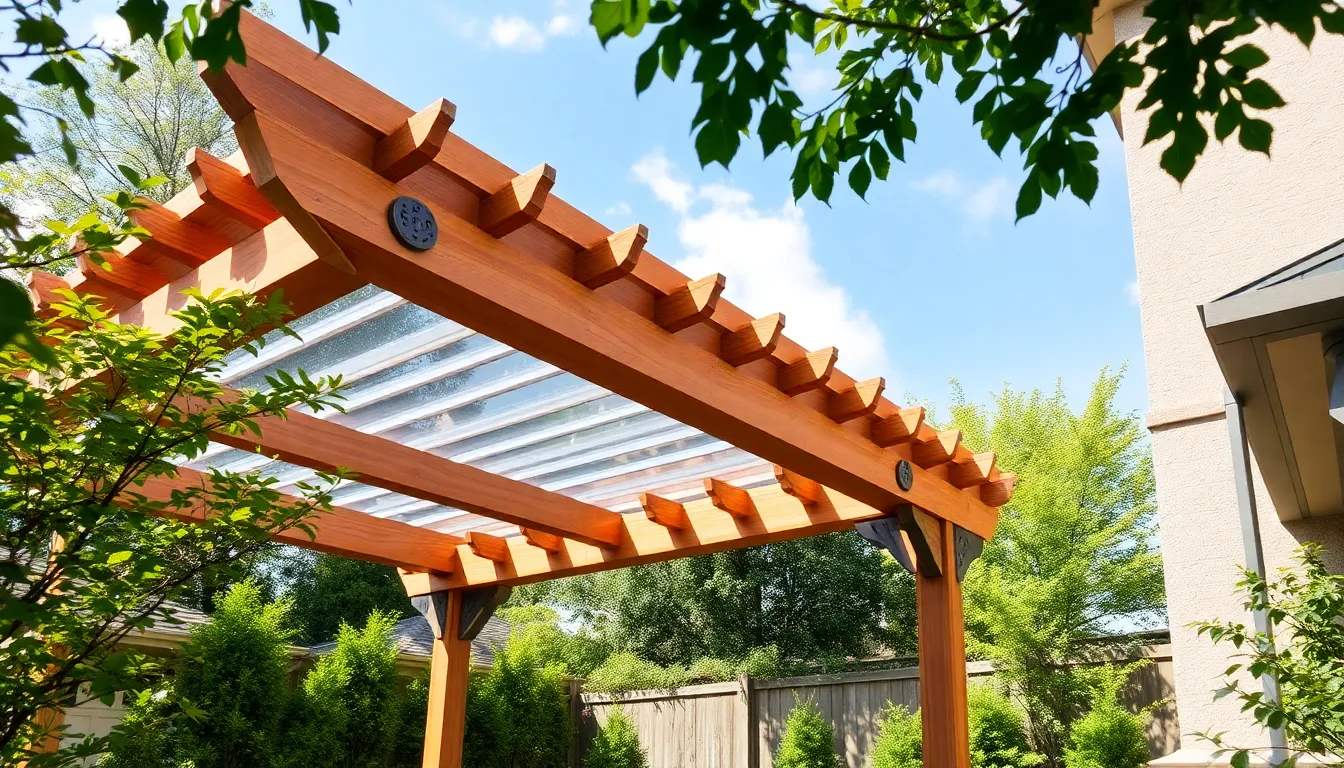
Transforming your attached pergola into a year-round outdoor sanctuary requires strategic weather protection features. We’ll explore essential add-ons that shield you from various elements while maintaining the open-air appeal of your patio space.
Side Panels and Privacy Screens
Side panels create intimate outdoor rooms while blocking unwanted wind and sun glare from neighboring properties. We recommend installing wood slat panels for a natural aesthetic that complements traditional home styles like colonial and craftsman designs. Lattice screens offer another attractive option, providing partial coverage that maintains airflow while adding visual interest to your pergola structure.
Fabric screens deliver flexible privacy answers that you can adjust based on weather conditions and personal preferences. These lightweight panels attach easily to pergola posts and come in weather-resistant materials that withstand UV rays and moisture. Custom-designed privacy screens allow you to match your home’s color scheme while creating designated spaces for different activities.
Retractable side panels provide the ultimate flexibility for your attached pergola system. You can extend these panels during windy conditions or when hosting intimate gatherings, then retract them completely for open-air entertaining. Installation typically requires mounting tracks along pergola posts, creating smooth operation for frequent adjustments.
Rain Protection Answers
Retractable canopies transform open pergolas into weatherproof outdoor rooms when unexpected showers arrive. We’ve found that waterproof fabric covers made from acrylic or polyester blends offer excellent rain protection while maintaining breathability. These materials resist mold and mildew buildup, ensuring your pergola remains fresh and clean throughout wet seasons.
Polycarbonate roofing panels deliver permanent rain protection without sacrificing natural light in your outdoor space. Clear panels maintain the open-sky feeling while directing water away from your patio furniture and entertaining areas. Textured panels provide additional privacy while still allowing filtered sunlight to reach your outdoor living space.
Guttering systems integrated into pergola designs channel rainwater away from your foundation and prevent pooling around seating areas. Professional installation ensures proper drainage slopes that direct water toward designated collection points or industry features. These systems work particularly well with solid roofing materials like polycarbonate panels.
Wind-Resistant Design Elements
Heavy-duty post supports using 6×6 mortised posts provide exceptional stability against strong wind forces that can damage lighter pergola structures. We recommend securing these posts with concrete footings that extend below the frost line in your region. Stainless steel hardware connections ensure long-term durability without corrosion from moisture exposure.
Decorative angle braces add both visual appeal and structural reinforcement to prevent swaying during windy conditions. These braces connect pergola posts to overhead beams, creating triangle supports that distribute wind loads effectively. Installation between posts and rafters creates multiple reinforcement points throughout your pergola framework.
Aluminum construction with vinyl coatings offers superior wind resistance compared to traditional wood materials. These lightweight yet strong frames flex slightly during high winds without breaking or splitting like wood alternatives. Corrosion-resistant properties ensure your pergola maintains structural integrity through decades of weather exposure, often backed by lifetime warranties from manufacturers.
Maintenance and Longevity Tips
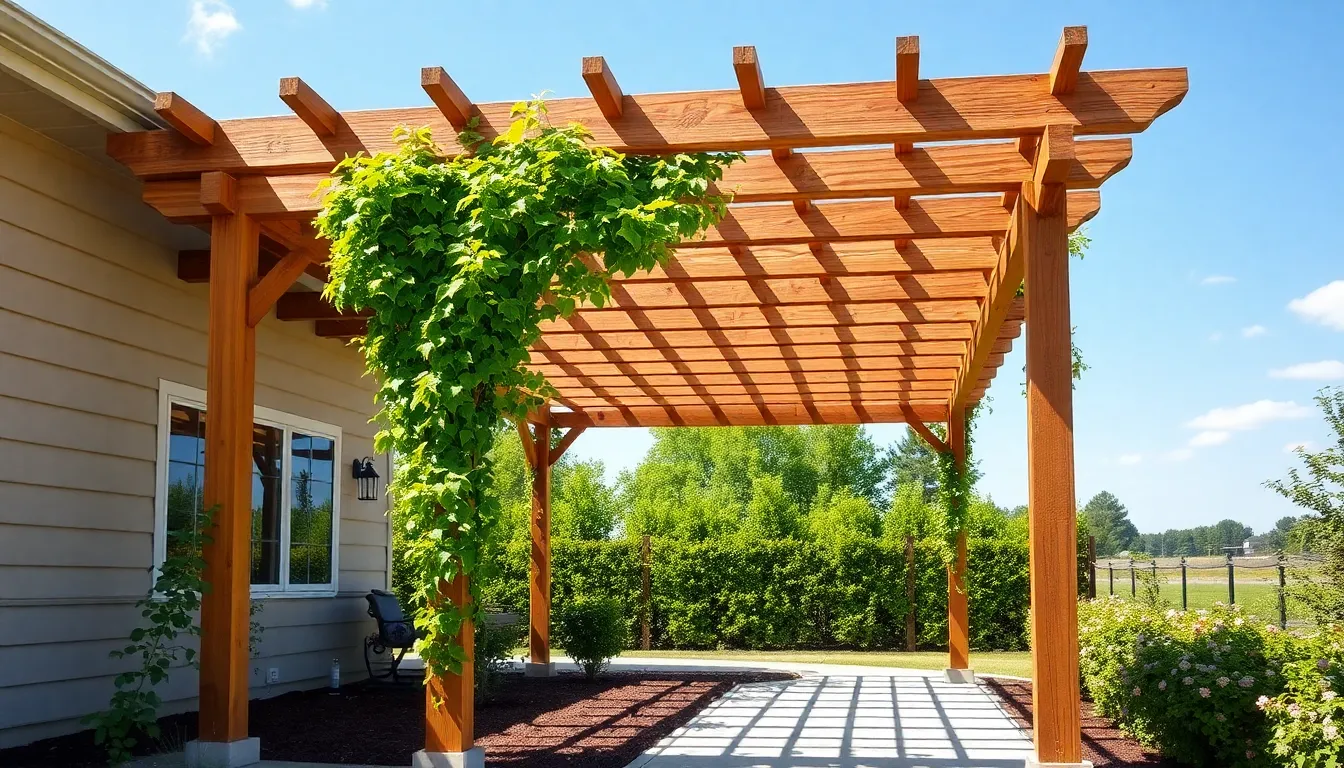
We’ll help you protect your investment and keep your attached pergola looking beautiful for years to come. Proper maintenance practices ensure both structural integrity and aesthetic appeal while maximizing your pergola’s lifespan.
Regular Cleaning Procedures
Wooden pergolas require consistent cleaning using a brush with warm water and mild detergent to prevent mold growth and remove accumulated dirt. Clean your wooden structure at least twice per year to maintain its natural beauty and prevent deterioration.
Vinyl pergolas need occasional washing with a garden hose or pressure washer for routine maintenance. Treat tougher stains on vinyl surfaces using warm water mixed with oxygen bleach for optimal results.
Aluminum pergolas demand minimal cleaning effort compared to other materials. Use a soft brush with gentle detergent periodically to remove dirt buildup, and apply warm water with a soft brush for scratches or stubborn debris.
Gutters and downspouts around your pergola should stay clear of leaves and debris to protect the structure. Maintain proper drainage by cleaning these systems regularly to prevent water damage to both your pergola and house connection.
Seasonal Inspection Checklists
Hardware components need inspection for looseness or rust formation, especially in retractable canopy mechanisms that require lubrication for smooth operation. Check all screws and joints at least quarterly to ensure structural stability.
Material exact issues demand targeted attention during each inspection cycle. Look for cracks, splinters, or warping in wooden pergolas, while checking for corrosion in metal structures and cracks or fading in vinyl components.
Structural elements including roof panels, beams, and supports require assessment for weather or pest damage. Ensure that shading systems and drainage components function properly during each seasonal review.
Critical repairs should receive priority attention early to prevent extensive damage from developing over time. Schedule regular maintenance on monthly, quarterly, or annual intervals depending on your pergola’s material and weather exposure levels.
Repair and Replacement Guidelines
Wooden pergola maintenance involves resealing and restaining every 3 to 5 years to preserve waterproofing and UV protection. Replace damaged or rotting wood immediately to maintain both structural integrity and visual appeal throughout the pergola’s lifetime.
Vinyl and metal pergola care requires addressing scratches, dents, or corrosion quickly to prevent further deterioration. Act swiftly when you notice these issues to maintain your pergola’s appearance and structural soundness.
Component exact repairs for retractable or louvered pergola systems should follow manufacturer guidelines for proper procedures. Consult these specifications to ensure warranty compliance and optimal performance of specialized mechanisms.
| Material Type | Lifespan with Minimal Care | Lifespan with Proper Care |
|---|---|---|
| Wooden Pergolas | 5 years | 12+ years |
| Vinyl/Plastic/Metal Pergolas | 15 years | 20+ years |
| Aluminum Pergolas | 15+ years | 20+ years |
Aluminum pergolas offer the best combination of durability and low maintenance requirements among common pergola materials. This makes them particularly ideal for long term attachment to houses where consistent performance matters most.
Conclusion
We’ve explored countless ways to transform your patio with an attached pergola that perfectly complements your home’s architecture. From traditional wooden designs to sleek modern metal structures these outdoor additions offer endless possibilities for creating your ideal outdoor living space.
The key to success lies in choosing the right materials design and features that match both your lifestyle and budget. Whether you’re drawn to DIY construction or prefer professional installation the investment in an attached pergola delivers immediate visual impact and long-term property value.
With proper planning thoughtful design choices and regular maintenance your new pergola will serve as the perfect bridge between indoor comfort and outdoor enjoyment for years to come.
Frequently Asked Questions
What is an attached pergola and how does it enhance outdoor spaces?
An attached pergola is a structure connected to your home that creates a seamless transition between indoor and outdoor living areas. It provides shade, aesthetic appeal, and transforms your patio into a functional outdoor room perfect for entertaining or relaxation. These structures can significantly boost property value while requiring no complete renovation.
What are the best wood types for traditional pergola construction?
Cedar is the top choice for wooden pergolas due to its natural durability and minimal maintenance requirements. Pine offers a budget-friendly alternative, while Douglas fir provides exceptional strength for larger spans. Each wood type can be enhanced with various stains and finishes to protect against weather and maintain appearance.
How do metal pergolas compare to wooden ones?
Metal pergolas, particularly aluminum and steel, offer superior durability and lower maintenance than wood. Aluminum is lightweight, weather-resistant, and often comes with lifetime warranties. Steel provides exceptional strength for bold architectural statements. Both can be powder-coated in various colors and require minimal upkeep compared to traditional wooden structures.
What are retractable canopy pergolas and their benefits?
Retractable canopy pergolas feature adjustable fabric coverings that can be extended or retracted as needed. They offer flexible protection from sun and rain, with options for motorized systems controlled by remote or smartphone apps. Manual pull-cord mechanisms provide a more budget-friendly alternative while still offering weather adaptability.
How should I integrate my pergola with my home’s existing architecture?
Match your pergola’s materials, colors, and design elements to your home’s style. Align the roof pitch for proper drainage, coordinate colors with existing trim, and consider using similar architectural details. Climbing plants can further enhance the visual connection between your pergola and house for a cohesive appearance.
What climbing plants work best for pergolas?
Popular choices include wisteria for dramatic spring blooms, clematis for continuous flowering, trumpet vine for attracting hummingbirds, bougainvillea for vibrant colors, and jasmine for fragrance. Select multiple varieties with staggered bloom times to ensure year-round visual interest and consider your climate zone when choosing plants.
What lighting options are available for pergola ambiance?
String lights offer charm and versatility for casual settings. Built-in LED fixtures provide modern aesthetics with energy efficiency. Solar-powered systems are eco-friendly and easy to install without electrical work. Each option extends your pergola’s usability into evening hours and creates a warm, inviting atmosphere.
How do I determine the right size for my pergola?
Measure your available space and consider proportional guidelines – your pergola should complement your home’s facade without overwhelming it. Plan for adequate clearance around outdoor furniture and ensure the structure extends your indoor living areas naturally. Consider vertical space for hanging plants or lighting features.
Can I build an attached pergola myself?
Yes, DIY pergola construction is accessible for homeowners with basic woodworking skills. You’ll need pressure-treated lumber, standard tools, and about two days of focused work. Use standard-sized materials and simple designs to reduce costs and complexity. Heavy-duty post bases can simplify foundation requirements.
What weather protection features can I add to my pergola?
Side panels and privacy screens provide wind protection and intimacy. Retractable fabric canopies offer flexible rain coverage, while polycarbonate roofing panels provide permanent weather protection. Integrated guttering systems ensure proper drainage. Wind-resistant design elements like heavy-duty supports maintain stability during storms.
How do I maintain my pergola for maximum longevity?
Regular cleaning and seasonal inspections are essential. For wood pergolas, check for rot and reapply stain every 2-3 years. Aluminum requires only occasional washing with mild soap. Vinyl needs periodic cleaning to prevent mildew. Address repairs promptly and trim climbing plants regularly to prevent structural damage.
What’s the typical lifespan of different pergola materials?
Aluminum pergolas offer the longest lifespan (20-30+ years) with minimal maintenance. Quality wood pergolas last 15-25 years with proper care. Vinyl pergolas typically last 10-20 years but require consistent cleaning. Steel pergolas can last 20+ years when properly powder-coated and maintained against rust.




